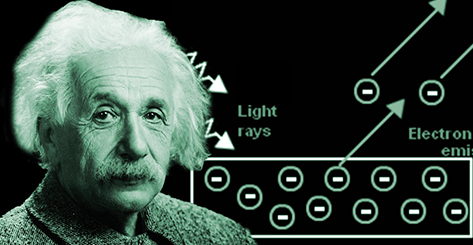The Einstein’s Equation of Photoelectric Effect describes how energy of an electromagnetic rays incident onto metal surface is distributed. When an electromagnetic ray falls on a metal surface , the energy absorbed by the electron is divided into two:
- Energy used to dislodge an electron from it’s orbit to the surface.
- Energy used as a kinetic energy to accelerate an electron from the surface
The energy of a photon can thus be expressed as sum of two energies:
| Energy of a photon | = | energy needed to dislodge an electron from metal surface | + | maximum kinetic energy gained by the electron |
The minimum energy needed to dislodge an electron from a metal surface is called the work function (Wo) of the metal. Work function energy varies from metal to metal.
Work function is expressed in a unit called electron-volt(eV) or joules (J).
1 eV = 1.6 x 10-19J.
Emission of photoelectrons occurs only when frequency incident onto the metal surface is above certain value. The minimum frequency to provide energy required to dislodge an electron from the metal surface is usually referred to as the threshold frequency(fo) of the given metal.
From the genera equation of the electromagnetic waves: c = fλ, the corresponding wavelength for the threshold frequency is known as threshold wavelength (λo) .
wo = hfo
which can also be expressed as :
when any radiation is of frequency f that is lower than fo , The energy it gives (hf) will be lower than Wo .
when hf= hfo, electrons are dislodged from their atoms but they just remain on the metal surface. An extra energy will be required to move them from the surface. That can happen if the radiation has extra energy besides that which is enough just to dislodged an electron and brings it to the surface.
Kinetic energy of a photoelectron comes from what remains after part of the electromagnetic waves energy has been used to extract an electron.

Thus when a wave is carrying an energy greater greater than the work function, the excess energy appears as the kinetic energy of the emitted electron.
from our earlier expressions of the wave energy, we see that:
me being the mass of an electron and v the velocity gained in the acceleration.
Thus total energy hf in a wave is usually expressed as:
since Wo = hfo the Einstein’s equation can be written as:
but since f =c/λ
c being the speed of light.
The table below shows work functions of some metals:

Example problems involving The Einstein’s Equation
Question one
The minimum frequency of light required to cause photo electric emission from potassium surface is 4.92 x 1014Hz. When the surface is irradiated using a certain source, photoelectrons are emitted with a speed of 6.51 x 105ms-1. Determine
- The work function of potassium
- The maximum kinetic energy of the photoelectron
- frequency of the source of radiation
(take h =6.63 x 10-34Js and me = 911 x 10-31Kg)
solution
Therefore:
3.
hf = hfo + K.Emax
hf= 3.26196 x 10-19 J + 1 .9304 x 10-19 J = 5.19236 x 10-19 J
E=hf
hence
Question 2
The threshold wavelength of a photoemmisive surface is 0.55\µm. calculate:
(a) its threshold frequency
(b) the work function in eV
(c) the maximum speed with which a photoelectron is emitted if the frequency of the radiation is 9.5 x 1014Hz(Take plank’s constant h=6.63 x 10-34Js and me =9.11 x 10-31kg)
solution
by using the general equation of speed of light:
from coulomb’s law:
Therefore, the work function in electron volts will be given by:
( c)
our earlier equation thus becomes:
and me is given as 9.11 x 10-31 kg
Factors that determines energy of photo electrons
The possibility of a radiation to eject photoelectrons from a metal surface is determined by:
- Intensity of the radiation
- energy of the radiation
- Structure of the material
what is Intensity of a radiation?
Intensity of a radiation is the rate of energy flow per unit area when radiation is perpendicular to the surface.
mathematically, Intensity can be expressed as:
that is;
but remember:
we can therefore rewrite intensity I as:
replacing w/t for p, we have:
Assuming the area to be circular with a radius r, then we can express A in terms of r such that:
A = πr2
It can therefore be shown that, Intensity is inversely proportional to area.
consider the setup below:

Intensity of the radiation is varied by changing the distance between the source and the surface of the cathode (r). The corresponding values of current is then recorded.
From the experiment, one discovers that the current increases when distance r is reduced.
From the basic law of charges, current I is directly proportional to the number of electrons. That is I = ne. where n is the number of electrons and e is charge on a single electron.
Hence, the photocurrent is directly proportional to the number of photoelectrons emitted per second. We can therefore conclude that the number of photoelectrons produced is directly proportional to the intensity.


Leave a Reply